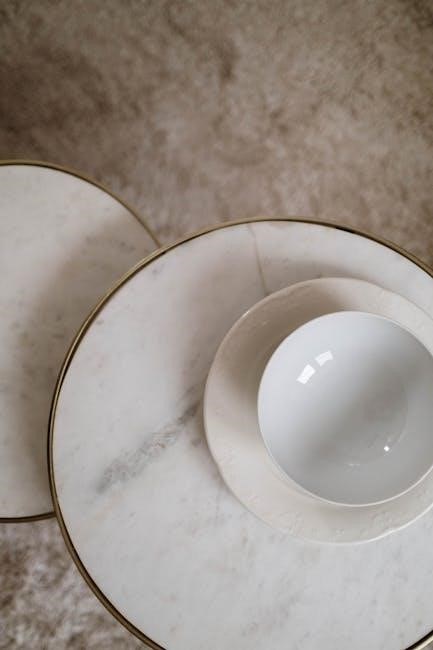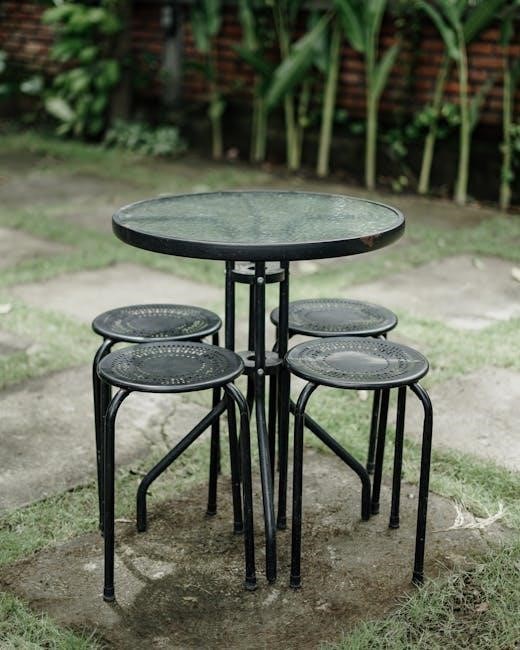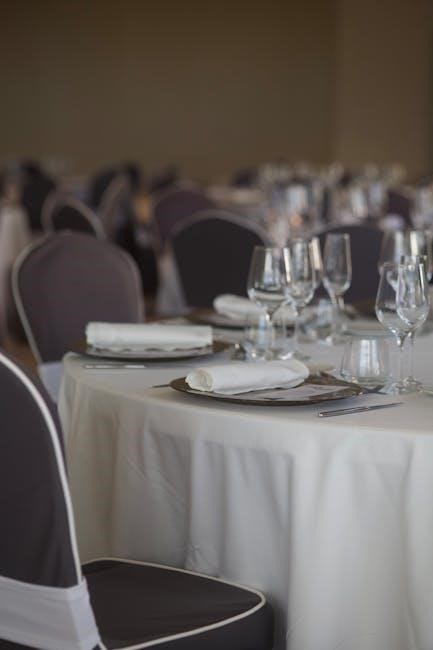A round dining table offers intimacy and encourages conversation, making it a popular choice for homes. However, selecting the right size can be challenging. This guide provides a comprehensive overview of round dining table dimensions to help determine the perfect fit for any dining area. Understanding the ideal size ensures functionality and aesthetics, creating a warm and inviting space for daily meals and special gatherings.
1.1 Importance of Choosing the Right Size

Selecting the right size for a round dining table is crucial for both functionality and aesthetics. The table should complement the room’s dimensions, ensuring ample space for movement and comfortable seating. A table that is too large can make the room feel cramped, while one that is too small may limit its usability for gatherings or daily meals.
The size of the table directly impacts the overall dining experience. A well-proportioned table fosters intimacy and conversation, which are key benefits of round dining tables. It also ensures that everyone can easily reach shared dishes and engage with others without feeling crowded or disconnected. Additionally, the right size ensures the table fits seamlessly with the room’s layout, creating a balanced and harmonious atmosphere.

Considering the number of people the table will accommodate is another critical factor. For instance, a table designed for six people requires a larger diameter than one meant for four, ensuring there is enough space for chairs and comfortable seating. Without proper planning, the table may not meet the needs of the household, leading to a less enjoyable dining experience.
Moreover, the table’s size influences the room’s flow and accessibility. In smaller spaces, a round table can be more practical than rectangular or square options, as it allows for better traffic flow and saves valuable floor space. However, in larger rooms, a generously sized round table can serve as a statement piece, enhancing the area’s elegance and functionality.

1.2 Benefits of Round Dining Tables
Round dining tables offer numerous benefits that make them a popular choice for many homeowners. One of the most significant advantages is their ability to foster intimacy and encourage conversation. Unlike rectangular or square tables, round tables eliminate the need for a “head” position, creating a sense of equality and inclusivity among all diners. This design promotes a warm and welcoming atmosphere, making it ideal for family gatherings, casual meals, and social events.

Another key benefit of round dining tables is their space efficiency. Without sharp corners, these tables can fit seamlessly into smaller dining areas or square-shaped rooms, maximizing the use of available space. They also allow for better traffic flow, as there are no protruding edges to obstruct movement. This makes them particularly suited for compact spaces, such as urban apartments or cozy dining nooks.

The circular shape of round dining tables adds a touch of elegance and sophistication to any room. Their smooth, curved lines create a visually appealing focal point, complementing a variety of interior design styles, from modern to traditional. Additionally, the lack of corners reduces the risk of accidents, making them a safer choice for households with young children or pets.
Round tables are also highly versatile. They can accommodate a wide range of seating arrangements, from intimate dinners for two to larger gatherings for six or more guests. This adaptability makes them a practical choice for households with varying needs. Furthermore, their symmetrical design ensures that every seat is equally comfortable and accessible, eliminating the discomfort often associated with corner seats at rectangular tables.
Factors to Consider When Selecting a Round Dining Table
When choosing a round dining table, consider the room’s dimensions, seating needs, and aesthetic preferences. Measure the space to ensure the table fits comfortably, allowing enough clearance for chairs and movement. Assess how many people it needs to seat and whether it complements the room’s decor. Balancing functionality and style ensures the table enhances the dining area’s ambiance and meets practical requirements.
2.1 Room Dimensions and Shape
When selecting a round dining table, the dimensions and shape of your dining room play a crucial role in ensuring a harmonious fit. Measure the room carefully, taking note of its length, width, and any obstacles like doorways or windows. The goal is to leave enough space around the table for comfortable movement and seating.
For small rooms, a round table with a diameter of 40-50 inches is ideal, as it saves space while still accommodating 4-6 people. In medium-sized rooms, a table with a 54-66 inch diameter works well, providing ample seating for 6-8 guests without overwhelming the area. Larger rooms can accommodate tables with diameters of 72 inches or more, offering plenty of space for 8 or more people.

The shape of the room is equally important. Round tables are particularly effective in square rooms, as they complement the symmetry and create a balanced layout. In rectangular rooms, a round table can serve as a centerpiece, breaking up the linear feel. For rooms with unusual shapes or tight spaces, a smaller round table or one with a pedestal base can maximize functionality.

Additionally, consider the clearance needed around the table. A general rule of thumb is to leave at least 36 inches of space on all sides to ensure comfortable seating and easy movement. This clearance also allows for the placement of chairs and any additional furniture, such as a buffet or china cabinet.
Finally, think about the flow of traffic in the room. The table should not impede movement between different areas of the house. If the dining room is part of an open-plan living space, the table’s size and placement should not disrupt the overall flow of the area.
By carefully evaluating the room’s dimensions and shape, you can choose a round dining table that enhances the space’s functionality and aesthetic appeal.
2.2 Number of Seats Needed
Determining the number of seats needed is a critical step in choosing the right round dining table. The size of the table should accommodate your household and any additional guests you plan to host. A general rule of thumb is to consider how many people will regularly use the table and add one or two extra seats for flexibility.
For small families or couples, a round table with a diameter of 40-50 inches is ideal, seating 4-6 people comfortably. Medium-sized tables, with diameters ranging from 54 to 66 inches, are well-suited for households of 4-6 people and can accommodate up to 8 guests for special occasions. Larger tables, measuring 72 inches or more in diameter, are perfect for big families or those who frequently entertain, offering seating for 8 or more people.
It’s important to balance the number of seats with the table’s size to ensure comfort. Overcrowding a table can make meals feel cramped, while too much space may reduce the intimate atmosphere round tables are known for. Consider the size of the chairs as well; larger or bulky chairs may require more space per seat.
Practicality also plays a role. If the table will primarily be used for daily meals, focus on seating your household comfortably. However, if you often host dinners or gatherings, opting for a slightly larger table ensures everyone can join without feeling squeezed. Remember, the goal is to create a welcoming environment where conversation flows naturally.

Ultimately, the number of seats needed should align with your lifestyle and entertaining habits. By matching the table size to your needs, you can enjoy a functional and inviting dining space that enhances everyday meals and special occasions alike.
2.3 Aesthetic and Design Preferences
When selecting a round dining table, aesthetic and design preferences play a significant role in creating a harmonious and inviting dining space. The table’s style should complement the overall decor of the room, blending seamlessly with the interior design. Consider the material, color, and finish of the table to ensure it aligns with your personal taste and the existing furnishings.
The shape of a round dining table inherently adds a sense of elegance and fluidity to a room. However, the design details can further enhance this effect. For instance, a table with a sleek, minimalist base, such as a pedestal or a tapered leg, can create a modern and airy feel. In contrast, a table with ornate or carved details may suit a more traditional or rustic aesthetic.
The edge of the table is another design element to consider. A rounded edge can soften the appearance of the table, making it feel more approachable, while a beveled or chamfered edge can add a touch of sophistication. Additionally, the color and finish of the table—whether it’s a natural wood tone, a painted hue, or a metallic surface—should harmonize with the room’s color palette and style.
Lighting and chair design also tie into the table’s aesthetic. A round table often serves as a focal point, so pairing it with the right chairs and lighting can elevate the space. For example, a chandelier or pendant light centered above the table can highlight its circular form, while chairs with complementary colors or patterns can enhance the overall design.
Ultimately, the table’s design should reflect your lifestyle and the atmosphere you want to create. Whether you prefer a formal, modern look or a cozy, rustic vibe, the right round dining table can serve as both a functional and decorative centerpiece for your dining area.

Standard Size Ranges for Round Dining Tables
Round dining tables come in various sizes, with diameters typically ranging from 36 to 60 inches. Small tables (36-42 inches) are ideal for intimate settings, while medium-sized tables (48-54 inches) accommodate 4-6 people comfortably. Larger tables (60 inches or more) suit big families or formal gatherings. Each size ensures ample legroom and comfortable seating, making them versatile for different spaces and needs.
3.1 Diameter Range for Small Tables
Small round dining tables typically have a diameter range of 36 to 42 inches (91 to 107 cm). These compact designs are perfect for intimate gatherings, small families, or spaces with limited room. A 36-inch table comfortably seats 2-4 people, while a 42-inch table can accommodate up to 5 individuals, depending on chair size and personal comfort preferences.
The smaller diameter makes these tables ideal for apartments, breakfast nooks, or cozy dining areas. They also provide a sense of closeness and ease of conversation among diners. When choosing a small round table, consider the space around it, as at least 24-36 inches of clearance is recommended on all sides for comfortable movement.
Despite their compact size, small round tables can still be stylish and functional. They come in various materials, such as wood, metal, or glass, allowing them to blend seamlessly with different interior designs. Additionally, some models feature foldable or extendable options, offering versatility for changing needs.



